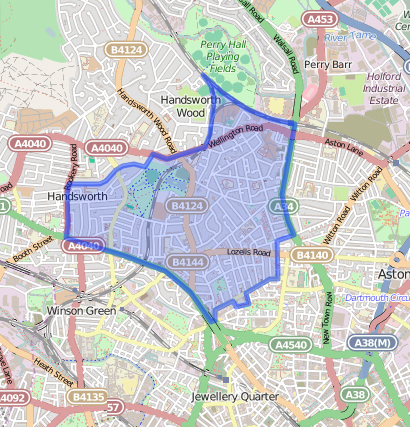Handsworth

The Handsworth neighbourhood (encapsulating the Lozells and East Handsworth ward) is located just over 2 kilometres north of Birmingham City Centre. It is one of the most densely populated areas of Birmingham. This frequently leads to overcrowding (nearly 1 in 5 households compared to less than 1 in 10 for England), and with several generations of the same family often sharing the family house. Housing is mainly in older terraces (46.9% of all property compared to 29% for Birmingham and 25% for England) with small backyards and opening straight on to the pavement at the front (Birmingham City Council, 2012).
The neighbourhood has a long history of migration where old migrants from areas such as Bangladesh and Pakistan, the Caribbean and Africa outnumber new, and with recent immigration adding to the diversity of the neighbourhood. GP Registration data indicates that people from 170 different countries moved to Handsworth in the period 2007-2010 (Phillimore, 2011).
In 2011, 31,074 people lived in the area, and with males (51.6%) slightly outnumbering females (48.4%). It has a younger profile than the city average, with nearly two-thirds of the population (63%) aged between 16 and 64 and 29% of the population aged between 0 and 15 (Office for National Statistics - ONS, 2011).
The most recent Indices of Deprivation (ID 2010) highlight that it is the fifth most deprived ward in Birmingham (out of 40). In addition, it is one of ten wards in Birmingham with the largest proportion of its population living in the 10% most deprived areas of England. Low income and unemployment are particular problems, with many dependent on benefits. Annual household income is around £19,000 per annum, compared to an England and Wales average of £35,000 per annum (ONS, 2011). 61% of the population are economically active, compared to a city average of 69%. This is reflected in a worklessness rate (those of working age not employed including those seeking work / not seeking work) in 2013 of 24.6%, compared to a citywide average of 16.7% (Birmingham City Council, 2013a).
In terms of key sectors of employment, there are relatively few larger employers in the area. The largest employer is Birmingham City College (450 employees). Only 8% of residents are employed in higher and intermediate occupations (ONS, 2011), whilst only 18% of residents (3,426 individuals) have a Level 4 qualification or above (Birmingham City Council, 2012).
With reference to super-diversity and health, it is possible to highlight various features of the population that are of relevance. In terms of ethnicity, the proportion of ethnic minority residents is well above the city average amounting to 88% of the population in total (42% Birmingham). The Asian ethnic group constitutes 60% of the total population. The next largest ethnic minority group is Black (22%), followed by the White population (12%) and then Mixed / other ethnic group (3% each). 682 and 497 individuals respectively). The Pakistani and Indian population are particularly evident constituting 24% and 22% of the total ward population (ONS, 2011).
Key languages spoken (in rank order) include English, Bengali, Panjabi and Urdu, followed by Pakistani Pahari (with Mirpuri and Potwari), Polish and Somali (ONS, 2011). In nearly 20% of households (19.3% - 1838 households), no individuals over the age of 16 have English as a main language (ONS, 2011). This can contribute to unemployment and / or individuals working in low paid and unskilled jobs in local factories.
Two-thirds of the resident population are Muslim, followed by Christian (21%), No religion (5%) and Sikh (4%) (ONS, 2011). Furthermore, nearly half of of the population in Handsworth (44.9%) were born overseas. Of those not born in the UK, those born outside the EU far outnumber those from other EU countries, although there is a sizeable minority of residents from EU accession countries (782 residents; 2011). Consequently longer established migrants are much more likely to be found in Handsworth compared to new migrants (i.e. residents less than 10 years born overseas – constitute 29% of total) (Birmingham City Council, 2013b). Of those not born in the UK, the majority arrived between the ages of 20-24 and 30-34, followed by 25-29 (Birmingham City Council, 2013b).
In overall terms the health of residents in Handsworth is worse than the average for England across a whole range of indicators. In particular, Infant mortality rates are higher than the national average and there is a high incidence of respiratory illnesses and heart disease. Teenage pregnancies are also a problem.
More specifically, Alcohol attributable admissions, Homelessness acceptances (15.7%; England 2.3%), Liver disease deaths preventable (24.3%; England 12.7%) and Respiratory disease deaths preventable (25.5%; England 11.6%) are much higher than average. In addition, Diabetes prevalence (7.0%; England 5.8%), Smoking prevalence (29.7%; England 20.0%) and Mental Health Prevalence (1.3%; England 0.8%) are also above average. However, Cancer deaths preventable (25.0%; 61.9% England), Communicable diseases deaths preventable (14.3%; England 29.9%) and Injuries due to falls 65+ were lower than average (Birmingham City Council, 2013c).
2011 Census data suggests that the proportion of residents in Very Good Health (43.6%) is lower than for Birmingham (45.5%) and England (47.2%). 17.6% of residents had a limiting long-term illness. This is slightly lower than the average for Birmingham (18.4%) and the same as for England (17.6%) (ONS, 2011).
References
Birmingham City Council (2012) Lozells and East Handsworth Ward – Economic Key Facts. Birmingham: Birmingham City Council.
Birmingham City Council (2013a) Worklessness briefing. Birmingham: Birmingham City Council.
Birmingham City Council (2013b) Population and Migration Topic Report. Birmingham: Birmingham City Council.
Birmingham City Council (2013c) Lozells and East Handsworth: Health Profile 2013. Birmingham: Birmingham City Council.
Office for National Statistics (ONS) (2011) 2011 Census.
Phillimore, J. (2011) Approaches to welfare provision in the age of super-diversity: the example of health provision in Britain’s most diverse city, Critical Social Policy 31 (1), pp.5-29.